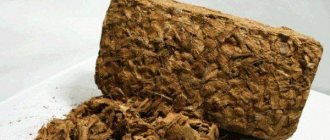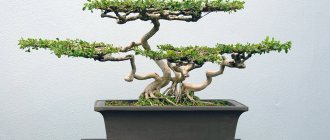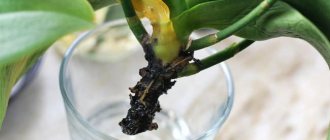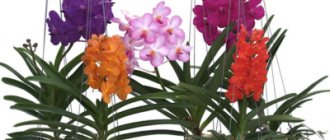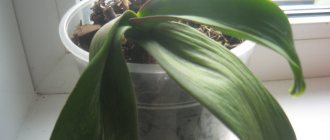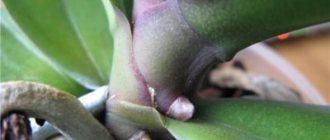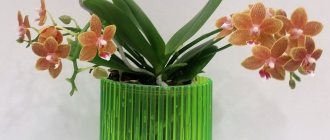There are a lot of ideas on how you can grow flowers at home, but glass orchid pots are one of the popular options. The method is new, but if you do not carefully study its features, you can make mistakes that will lead to the death of the plant.
An orchid without a substrate or in the ground should be only partially immersed in a flowerpot, which will allow it to remain outdoors. The sockets at the base should be placed flush with the edge of the container. Support is required, for which you can use wire.
The importance of choosing the right pot
The root system of phalaenopsis needs oxygen more than others : they actively participate in the process of photosynthesis and cannot cope with excessive moisture. Plus, ideal aeration of both the roots and the substrate in the container is vital for them.
The reason is in the structure of the roots: the roots are covered on top with velamen - a hygroscopic tissue filled with air. If the air in the root area does not circulate, the velamen begins to rot, and without this shell, the orchid will not be able to absorb the necessary microelements.
This is why transparent plastic pots are chosen for transportation and sale.
What should the “correct” container provide?
The “correct” pot should:
- allow excess moisture to escape without delay;
- allow air to circulate inside, providing the roots with the proper amount of oxygen;
- allow the root system to grow without problems, without oppressing it;
- provide the necessary temperature conditions (not allowing the root system to overheat or overcool) and access of light to the roots;
- allow you to safely remove the plant from the container without damaging the root system.
How to choose?
The number of pots on store shelves is amazing, and people who have been growing orchids for a while now find it difficult to make the right choice.
Consider the following nuances:
- The pot must have several drainage holes (at least 4) or the ability to make them yourself (not only at the bottom, but also on the sides).
- The diameter of the container should be 3-4 cm greater than the size of the root system. Height is approximately equal to width.
- The most acceptable material is soft plastic, transparent or light colors.
In what containers should you not plant a flower?
There are pots in which it is strictly not recommended to plant orchids:
- Made from unfired ceramics (the roots of the plant grow to the inside and are injured during transplantation).
- Pots are oblong (in such containers the flowers do not receive full air and moisture).
- The containers are too wide and deep for growth. Phalaenopsis grows very slowly, and excess soil will only hinder it.
You cannot grow phalaenopsis in the same pot with any other plant: the orchid will not bloom.
Treatment
The vase must be washed periodically, as the following accumulates on the inner walls:
- Algae layer;
- And mineral deposits.
The disinfection procedure or prevention can be carried out using:
- A weak solution of potassium permanganate (of course, the plant should be removed);
- Or fungicides.
This orchid is susceptible to diseases such as:
- Spotting, which may be caused by excessive moisture in the substrate or air. In diseased plants, wart-like spots form on the underside of the leaf. It is often caused by fungal diseases that actively develop in warm and damp rooms. In this case, rounded black spots appear on the upper side of the leaves. Orchids fight spotting by creating a favorable environment for the flower. When planting plants, the substrate is disinfected. Water Wanda with water in which special antifungal drugs such as Trichodermin or Fitosporin are dissolved.
- Rot caused by waterlogging of the substrate. Most often, the disease progresses on cool days or when using containers that are unsuitable for the orchid. With this disease, rotting of roots and stems is observed. The tissues of the flower soften and turn black. Very quickly the plant turns yellow and dies. To combat this disease, the substrate is disinfected before planting orchids. The plant is watered in accordance with the requirements of agricultural technology. The drug "Maxim" is added to the water.
| Manifestation | Cause | Elimination method |
| Round black markings appear on the leaves along their entire length. | Fungal infection. | Treat infected areas with a fungicide. Reduce the frequency of watering to once a week, maintain a constant temperature of 23... 25 °C. Cover with a cloth, avoid bright light. |
| The horse system rots, becomes covered with a black coating and dies. The stem with leaves dries up. | Bacterial rot. | Remove infected areas and cover cut areas with phytosporin. Replace the soil and disinfect the container. Antibiotics (tetracycline) are also effective in a ratio of 1 gram per liter. |
| Black dots appear on the outside of the leaf, and the stem may become covered with brown lines. | Viral infection. | It is impossible to completely cure. You should get rid of the infected plant to avoid spreading the infection. |
| Small green insects appear throughout the orchid. The stems and leaves wither and the plant dies. | Aphid. | Increase the air humidity, treat the flower with a soap solution or tincture of lemon zest. Special intestinal preparations (Intavir, Actofit) are best suited for pest control. |
| Small beige pests on leaves, flower stalks, buds and stems. White coating and waxy deposits. Wanda is fading. | Mealybug. | Remove growths and affected parts of the plant. Treat the bulb with an alcohol solution and remove the parasites. Aktara, Mospilan, Aktellik, Calypso are excellent for wrestling. |
| Small voids appear on the leaves and stem. Yellow spots appear, shoots die. | Shield. | A solution of soap and alcohol, fern tincture and chemicals such as Permethrin, Bi 58, Phosfamide, Methylmercaptophos will help get rid of the pest. |
Advantages and disadvantages of different types of pots and their photos
Clay
Clay flowerpots are used less often than plastic ones. Advantages:
- Since clay is an environmentally friendly and porous material, it allows the soil to “breathe”.
- The material retains liquid, releasing it gradually to the soil.
- The clay container is very stable and will not tip over under the weight of the flower.
- It looks aesthetically pleasing and fits into almost any interior.
Disadvantages of clay:
- If you plant a flower in a pot made of untreated clay, the roots of the orchid will begin to grow to it.
- Clay heats up quickly when standing in the sun or near a heater. Naturally, moisture evaporates faster.
Buy a smooth, poured ceramic vessel, slightly larger than the root system and, preferably, a light color.
Once you buy a clay pot, do not plant the orchid in it on the same day. Place the container in a bowl of water for several hours: the clay will be saturated with moisture and will accumulate less salt in the future.
Glass
Since glass pots do not have drainage holes, the plant's roots will quickly begin to rot. You can buy glass containers only if the room where the orchid grows has very low humidity (which happens quite rarely). In this case, the drainage layer should occupy half the container, and the glass should be transparent, without dark patterns.
And, of course, a glass pot can be used not as the main flowerpot, but as a flowerpot for beauty .
Basic principles of care
The main operations for caring for an orchid in a vase are watering, fertilizing, and preventing diseases. Labor costs for changing soil and replanting are reduced.
Flasks must be washed regularly
In order for the composition to have a decorative appearance, the flask must be washed to remove algae and salt deposits about once a month. Plants in hydroculture are removed once a year, the roots are inspected, and the salted layer of expanded clay (diatomaceous earth) is replaced.
Watering
Much attention is paid to the quality of water: ordinary water from the tap is clogged with metal salts; orchidists recommend using rainwater or purified by osmosis with the addition of up to 10% tap water.
At home, you can filter water through peat, which removes excess calcium and reduces excess pH.
Hydroculture irrigation technique:
- In expanded clay: sprayed from above, then watered with water and fertilizer.
- In perlite, diatomaceous earth, green mix: spray generously, then carefully pour over the inner wall of the vase.
Important: Once a month, the plant is irrigated with plenty of water to dissolve accumulated salts.
Technique for watering orchids on a block:
- Remove the block from the greenhouse once every 2 weeks;
- immerse for 10-15 minutes in warm water, during the growth period - with fertilizer;
- attach in place.
- if the flowerpot is open, spray the orchid daily.
in winter
In winter, watering and spraying in the flowerpot is reduced. The vase with the plant is protected from drafts and isolated from the cold windowsill with a wooden stand.
Phalaenopsis and vanda growing in expanded clay can be dried until the roots appear silvery. The roots are inspected for rotting.
For orchids resting for the season, the water in the vase is maintained at a level of up to 1 cm - it does not contain fertilizers, it is added in a thin stream along the inner wall of the pot.
Feeding
Fertilizers for orchids are added to irrigation water according to the instructions, without exceeding the dosage. Generally accepted norm:
- during the growth period - 1 ml per 1 liter of water;
- during the rest period - 0.5 ml per 1 liter.
When in doubt, it is better to pour the product in a lower concentration than indicated on the package.
Prevention of possible diseases
Prevention of orchid diseases consists of maintaining optimal conditions:
- moderate temperature 20-25°C, at night not lower than 18°C;
- diffused light;
- timely removal of rotten roots;
- if necessary, spraying against pests, treating with fungicide.
How to do it yourself?
Advantages and disadvantages
Do you want to make a pot with your own hands? Nothing is impossible! But keep in mind that you will have to try.
Of course, there are advantages to this. You can make a container of the size that suits you: for example, if the roots of your orchid are damaged, you will need a very small pot . And these are not always on sale. However, you will have to spend time on work and, quite possibly, your first craft will not be very attractive in appearance.
Is it worth making the container yourself or is it better to buy it?
If you are not sure that you can handle the job, or you simply don’t have time, buy a potty in the store.
Preparation of materials and tools
There are several options for making a pot. You may need the following items:
- Coconut shell.
- Pine planks.
- Drill.
- Thick fishing line or copper wire.
- Plastic bucket.
Manufacturing
- Scoop out the meat from a large coconut, wash it and dry it. Using a drill, drill several holes on the sides and bottom. This pot allows you to create ideal tropical conditions for mini orchids.
- Take any plastic bucket (like an ice cream bucket) and make holes in it. Instead of a drill, you can use a hot nail. Decorate your creation with bright fabric, wire or other materials to your liking.
- The pine basket is made from pine planks of suitable size. They are polished and fastened together with wire or a special adhesive.
- A hanging basket made of bamboo or wood is also suitable for growing orchids. But don't forget to put a champagne cork at the bottom. Thanks to this, the roots will not be pressed into the bottom of the container.
Pros and cons of keeping orchids in water
You can grow a healthy orchid at home without a substrate, in liquid. But this should not be water straight from the tap, but a nutrient mixture containing a full range of microelements.
This method of growing orchids is called hydroponics.
Advantages:
- no risk of plant infection by rot and parasites living in the substrate;
- there is no need to change the soil, replanting the orchid and thereby causing additional stress;
- there is no shortage of nutrients;
- the roots are always moistened, and the plant itself blooms healthy and profusely.
What if the plant was transplanted into the wrong container?
If you chose the wrong container, your orchid will quickly let you know. A “swamp” in the substrate, the germination of greenery or algae is a signal that the flower needs to be replanted urgently. Otherwise, its root system will soon rot. Replanting will also be required if the capacity for the plant is clearly large.
If you notice that a blooming orchid has begun to fall on its side, tie it up and place the pot in a glass flowerpot. Replant later when flowering ends.
If you want your green pet to look fresh, bloom brightly and rarely get sick, take care in advance of the container for planting it. In the article we have listed all the important nuances of choice. It's up to you!
Beautiful examples
An ordinary flower vase can easily be transformed into a classic flowerpot. It will be enough to fill the bottom with a fairly high layer of drainage and place the flower inside in a transparent plastic pot. You can make it look deliberately careless if you stick a sticker of black paper on which you write with chalk on the surface. On the resulting label you can sign the orchid variety or even give a name to the green “pet”.
Another stylish and laconic solution would be to place the flower in a bowl-shaped pot with a white glossy surface. Its size will even allow you not to limit yourself to one plant, but to plant several varieties at once.
Elongated ceramic pots can be made in different sizes and even shapes. A classic white rectangular vessel will complement a minimalist interior, while a rich lavender one will fit perfectly into a Scandinavian or modern style
To learn how to choose a pot for an orchid, see the following video.
